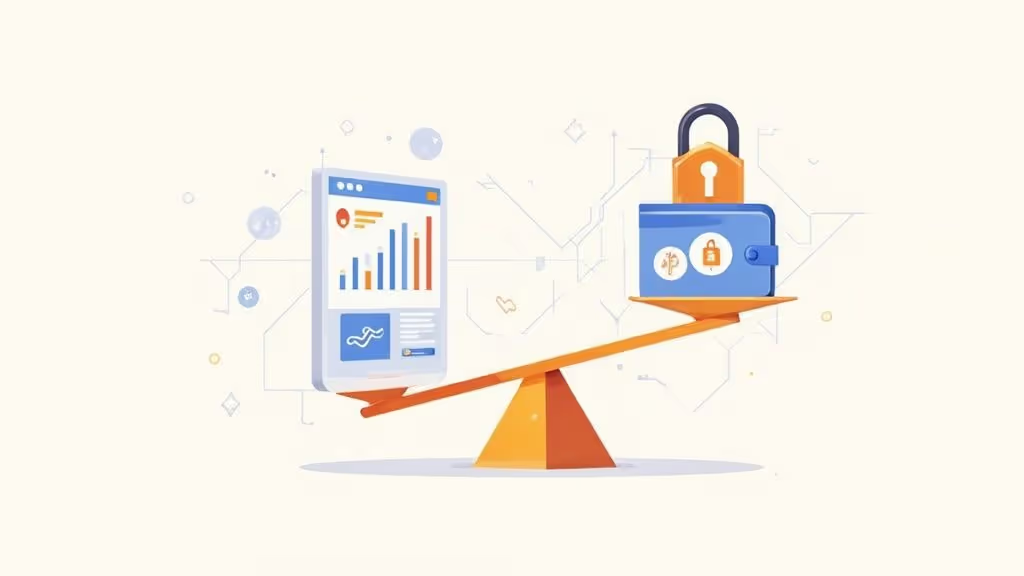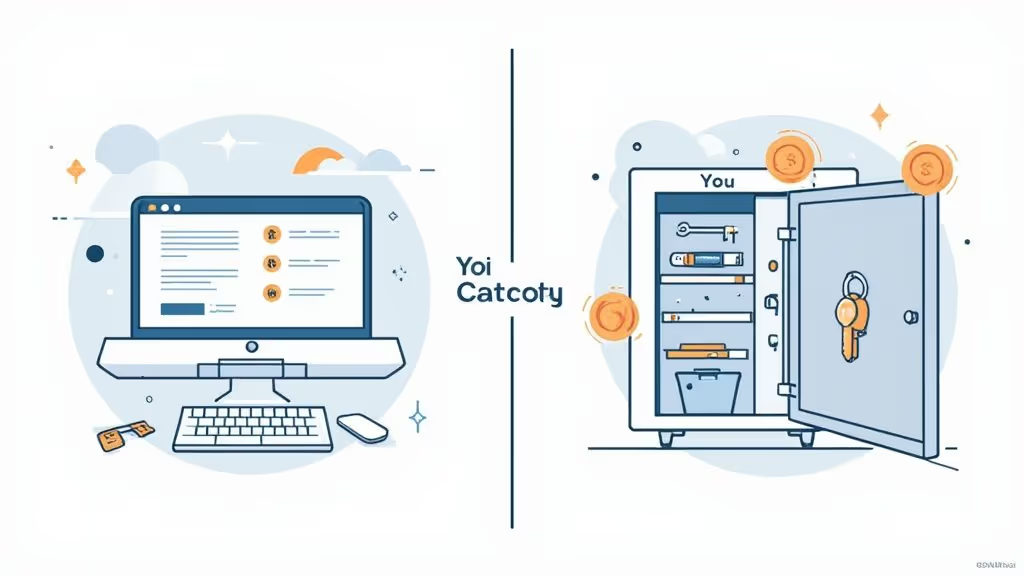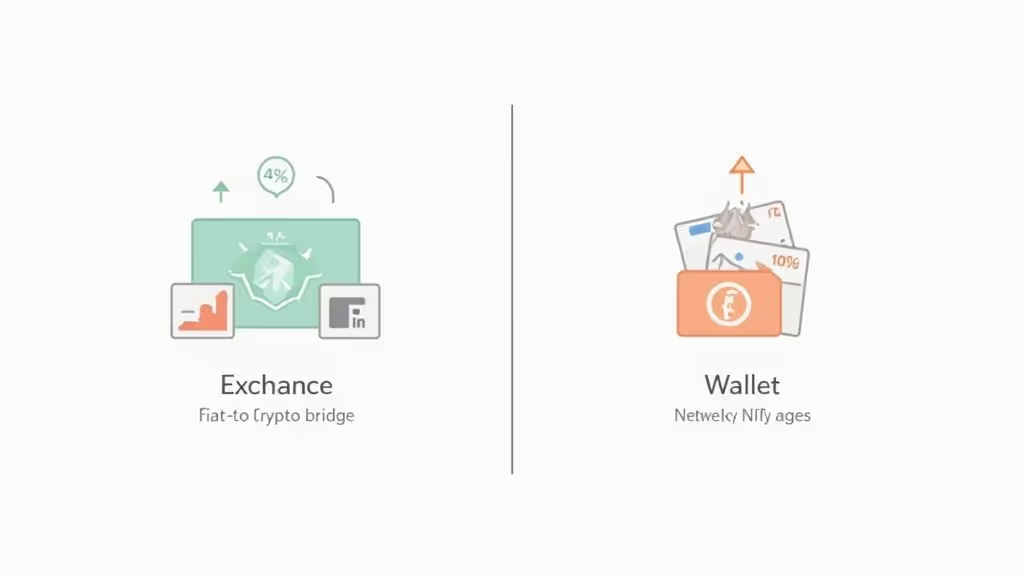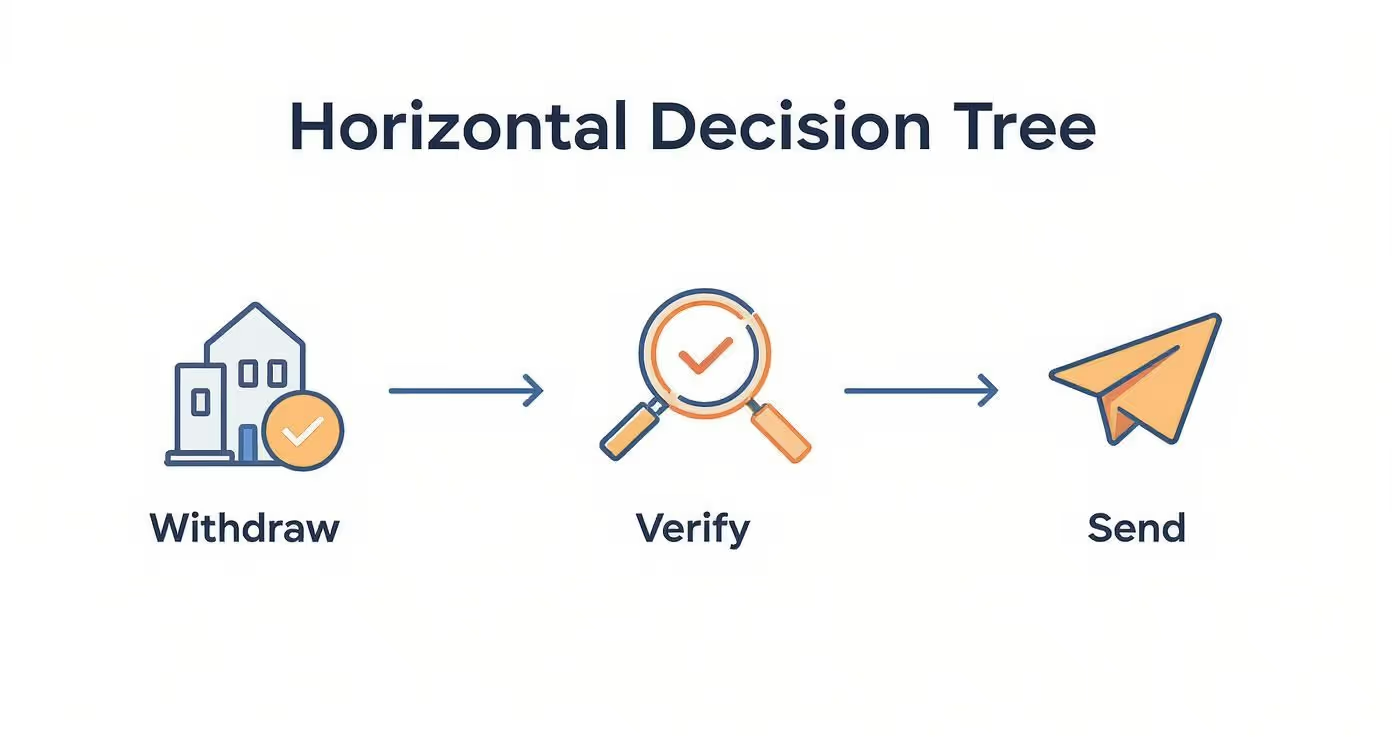Coin Profitability Calculator: Your 2024 Guide
Unlock smarter crypto decisions with our guide to using a coin profitability calculator. Learn to accurately forecast mining and trading profits.

December 21, 2025
Wallet Finder

November 7, 2025

When you're trying to figure out the difference between a crypto exchange and a wallet, it really boils down to one word: control. Exchanges are marketplaces for buying, selling, and trading crypto, but the platform holds your assets for you. On the flip side, wallets are your personal digital vaults where you're in charge, giving you complete and total ownership.

If you're new to crypto, it’s easy to get these two mixed up. You can see your Bitcoin balance on Coinbase, so that’s a wallet, right? Not exactly. The real difference is custody, which is just a fancy way of asking who actually holds the private keys to your crypto.
A crypto exchange is custodial. It’s a lot like a traditional bank. You deposit your money, and the bank keeps it safe while letting you make transactions. You're trusting them with your funds. In the same way, an exchange holds onto your crypto, giving you a convenient place to trade.
A crypto wallet, however, is non-custodial. Think of it like having cash in your pocket. You, and only you, can access it. With a crypto wallet, you hold the private keys, which means you have direct, sovereign ownership of your digital assets. This single distinction impacts everything from your security to your freedom.
To make this crystal clear, this table cuts straight to the chase, highlighting the distinct roles of exchanges and wallets.
FeatureCrypto Exchange (Custodial)Crypto Wallet (Non-Custodial)Primary PurposeBuying, selling, and trading crypto assetsSecurely storing, sending, and receiving assetsAsset ControlThe exchange holds your private keys for youYou hold your own private keys—"not your keys, not your crypto"SecurityYou're trusting the exchange's security measures and protocolsYou are 100% responsible for your own securityBest ForActive trading, converting fiat-to-crypto, and accessing a wide range of market ordersLong-term holding (HODLing), interacting with DeFi apps, and managing NFTs
This isn't just a technical detail; it has massive real-world implications. The crypto exchange market cap hit $63.38 billion, showing just how central these platforms are for providing liquidity. While roughly 70% of crypto transactions happen on exchanges, the explosive growth in DeFi and NFTs is pushing more people toward personal wallets for direct on-chain interaction.
Key Takeaway: Exchanges give you convenience for trading, but wallets give you true ownership. The choice isn't about which is "better"—it's about using the right tool for the job at hand.
Most exchanges are centralized platforms (CEXs), but there’s a whole other world of decentralized crypto exchanges (DEXs) that blur the lines a bit. Ultimately, what you choose should depend on your goals. Are you an active trader trying to catch market swings, or a long-term believer securing your assets for the future? Your answer will point you in the right direction.

When you get into the crypto exchange vs. wallet debate, it always comes back to security. But it’s not as simple as just repeating the mantra "not your keys, not your coins." The real heart of the matter is custody—who holds the private keys that control your assets?
This one question defines your entire risk profile.
With a crypto exchange, you're handing over your assets to a third party. In this custodial model, the exchange takes on the job of securing your private keys for you. While that definitely introduces counterparty risk, let's be realistic: top-tier exchanges pour millions into security systems an individual could never dream of building.
They use a layered defense strategy built to protect billions in user funds.
Even with these heavy-duty measures, there are no guarantees. You're still trusting a centralized company, and that comes with its own set of vulnerabilities. The biggest threats are massive platform hacks, asset freezes ordered by governments, or the exchange simply going bankrupt.
While major exchanges have become fortresses, the risk of a catastrophic event, though smaller, is never zero. You're trading a bit of control for a lot of convenience.
A non-custodial wallet is the polar opposite. You and you alone hold the private keys. This is the core principle of decentralization in action—no one else can touch, freeze, or lose your funds.
But this complete control comes with complete responsibility. Your security is now entirely in your own hands. You have to protect your private key and its backup, the seed phrase, from everything: phishing attacks, malware, and even just losing the piece of paper you wrote it on.
There are two main types of non-custodial wallets, each offering a different balance of security and convenience. If you're diving into DeFi, you'll need to know the difference. You can get a deeper look in our guide on what is a DeFi wallet.
Ultimately, the choice between an exchange and a wallet is a personal risk assessment. You have to be honest with yourself: do you trust an institution's security more, or do you trust your own ability to keep your keys safe?

Security is one thing, but the practical, day-to-day experience boils down to what you can do and what it costs. This is where exchanges and wallets really diverge.
Think of an exchange as a high-speed financial marketplace built for one thing: trading. A wallet, on the other hand, is your personal key to the entire on-chain world. Figuring out how these differences in function and fees impact your bottom line is crucial.
Crypto exchanges are built to feel familiar, especially if you've ever used a stock brokerage app. They're packed with tools designed for active traders who need speed, deep liquidity, and precision execution. Their entire purpose is to make buying, selling, and swapping assets as smooth as possible.
The biggest draw for an exchange is that massive pool of buyers and sellers, which allows for complex trading strategies that a standard wallet just can't support.
Here’s a breakdown of what you'll find on a typical exchange:
Key Insight: Exchanges are all-in-one platforms that bundle trading, fiat conversion, and market analysis together. Their fee models are designed to profit from the high volume of trades they facilitate.
A non-custodial wallet completely shifts the focus from a trading floor to direct blockchain interaction. At its core, it’s about securely sending, receiving, and holding your assets with you as the sole controller.
But modern wallets have evolved far beyond simple digital piggy banks. They are your gateway to the decentralized web.
These fees are dynamic and fluctuate wildly with network congestion. During peak times, a simple token swap could easily cost you more than dozens of trades on a centralized exchange. For a much deeper dive, our guide breaks down everything you need to know about Ethereum gas fees.
The table below lays out these different cost structures side-by-side.
FeatureCrypto Exchange (Custodial)Crypto Wallet (Non-Custodial)Transaction CostFixed percentage trading fee (e.g., 0.1%)Variable network fee (gas) based on congestionWithdrawal CostFixed fee per asset (e.g., 0.0005 BTC)Only the network fee for the transferFunctionalityTrading, fiat conversion, market ordersdApp interaction, DeFi, NFT managementBest for...High-frequency trading, small trades, fiat conversionLarge transfers, DeFi, long-term holding
So, which is better? It really comes down to what you’re trying to do. For frequent, smaller trades, an exchange's low percentage fee is almost always more cost-effective. But for moving a large amount of crypto or diving into DeFi, a wallet's one-time network fee is often the smarter financial move.
Deciding between a crypto exchange and a wallet isn't about finding one winner. It’s about matching the right tool to your goals, risk tolerance, and what you’re actually doing with your crypto. Honestly, the best approach usually involves using both, but for entirely different things.
The first step is figuring out what kind of user you are.
Your Tool: Crypto ExchangeFor the active trader, speed and liquidity are everything. You need to execute trades in a flash to catch market movements, and for that, a crypto exchange is your command center.
Your Tool: Hardware WalletIf your game plan is to buy and hold, your focus shifts completely from speed to hardcore security. For this, a non-custodial hardware wallet is non-negotiable.
Your Tool: Software WalletFor anyone drawn to the wild frontiers of Decentralized Finance (DeFi), NFTs, and DAOs, a non-custodial software wallet is your passport. These "hot wallets," like MetaMask or Phantom, are the bridge connecting you directly to thousands of decentralized applications (dApps).
The data shows this clear division of labor. While top centralized exchanges saw a jaw-dropping $5.1 trillion in spot trading volume in a recent quarter, wallets are what power the real on-chain economy. In just one month, stablecoin transaction volume hit $1.25 trillion, and over 64% of that was settled directly on blockchains like Ethereum and Tron, mostly through wallet-to-wallet and wallet-to-dApp interactions. You can discover more insights in the 2025 State of Crypto Report.
Just getting started? The amount of information can feel like drinking from a firehose. For newcomers, the best way forward is a hybrid strategy that balances ease of use with the crucial skill of self-custody.
This step-by-step approach lets you use the convenience of an exchange while you slowly build the confidence and skills needed for the freedom of self-custody.
Moving crypto off an exchange and into your own wallet is a right of passage. It’s the moment you go from just trading digital assets to actually owning them. While the process itself isn't complicated, the stakes are incredibly high—one tiny mistake can mean your funds are gone forever.
Here is a step-by-step, actionable checklist to follow every single time.
Remember, blockchain transactions are final and irreversible. There’s no bank to call. This methodical checklist is your best protection against costly errors.
Deciding between an exchange and a wallet isn't a one-and-done choice. The truth is, any smart crypto strategy uses both, letting each tool shine where it’s strongest. The goal is to build a simple framework that matches your actions to the right tool, so you’re always balancing easy access with rock-solid security.
This isn’t about picking a winner; it's about building a system. Think of your exchange as the bustling marketplace—your on-ramp from fiat and your arena for fast-paced trading. Your wallet, on the other hand, is your personal vault and your passport to the decentralized web. Knowing when to use each is one of the most critical skills you can develop, and tools like Crypto Average Calculator Your Guide to True P&L can help you understand your real profits and losses.
This simple flow chart maps out the standard, secure process for moving your assets from a centralized platform into your own custody.

The visual breaks down the transfer into three essential steps: starting the withdrawal, triple-checking the address, and confirming the transaction. This methodical approach is your best defense against common, and often costly, mistakes.
To make this even easier, use this quick-reference table as your go-to guide for making the right choice, every single time.
Your GoalPrimary ToolKey ReasonBuying crypto with dollars/eurosCrypto ExchangeIt's the only regulated and direct bridge from fiat to crypto.Making frequent tradesCrypto ExchangeOffers the deep liquidity, low fees, and instant settlement needed for trading.Storing assets long-term (HODL)Hardware WalletKeeps your private keys completely offline, offering maximum security from hacks.Interacting with DeFi or dAppsSoftware WalletActs as your secure login and transaction signer for the decentralized web.Securing your main portfolioHardware WalletRemoves the risk of losing your assets if an exchange gets hacked or goes bust.Cashing crypto back into dollarsCrypto ExchangeProvides the only practical off-ramp to turn digital assets back into cash in your bank.
This table clarifies the distinct roles each tool plays in your crypto journey. By aligning your actions with the right platform, you protect your assets and streamline your workflow.
The most successful crypto users operate with a clear system: Exchanges are for transacting; wallets are for owning. This simple mental model will protect your assets and empower you to explore the full potential of the on-chain world.
Ultimately, your personal framework will evolve. As you get more comfortable in the space, you'll naturally start shifting more of your activity toward non-custodial wallets. Stay curious, keep learning, and adapt your system as your crypto journey unfolds.
When it comes to exchanges and wallets, a lot of questions pop up. Let's clear the air with some straightforward answers to the most common ones.
You could, but it’s a risky move for any serious amount of crypto or for long-term holding. When you leave your assets on an exchange, you’re trusting them with your private keys. This creates custody risk—if the exchange gets hacked, goes bankrupt, or decides to freeze your account, your funds could be lost for good.
Think of an exchange as a temporary stop for buying, selling, and trading. For genuine ownership and peace of mind, moving your crypto to a non-custodial wallet you control is always the smarter play.
If you lose your private key—and more importantly, the backup seed phrase that comes with it—your crypto is almost certainly gone forever. There’s no “forgot password” link or customer service agent to call. This is the harsh reality of self-custody and the immense personal responsibility that comes with it.
Your seed phrase is the ultimate master key to your funds. Guard it like your life depends on it. Store it offline, in multiple secure locations, and never, ever type it into a website or share it.
This is the core trade-off: an exchange gives you recovery options but holds the keys. A wallet gives you absolute control, which unfortunately includes the risk of absolute, irreversible loss if you're not careful.
Not really. Pseudonymous is a much better word for it. Your real-world name isn’t directly attached to your wallet address, but every single transaction is recorded on the public blockchain for anyone to see.
This is a world away from centralized exchanges, which demand Know Your Customer (KYC) verification. On an exchange, your identity is directly tied to every move you make. A personal wallet provides a much higher degree of privacy, but don't mistake it for true anonymity. Determined analysts can sometimes trace on-chain activity back to real-world identities.
Most savvy crypto users run with at least two different wallets. It’s a simple way to separate your funds, manage risk, and find a good balance between daily convenience and iron-clad security.
It’s just like your regular finances. You keep a bit of cash in your physical wallet for daily expenses but put your life savings in a secure bank vault. In crypto, that vault is your own cold storage.
Ready to stop guessing and start learning from the best? Wallet Finder.ai gives you the on-chain intelligence to track top-performing wallets, discover profitable trades, and mirror winning strategies in real time. Find your edge and act on smart money moves before the rest of the market. Start your 7-day trial and trade smarter today.
"I've tried the beta version of Walletfinder.ai extensively and I was blown away by how you can filter through the data, and the massive profitable wallets available in the filter presets, unbelievably valuable for any trader or copy trader. This is unfair advantage."
.avif)
Pablo Massa
Experienced DeFi Trader